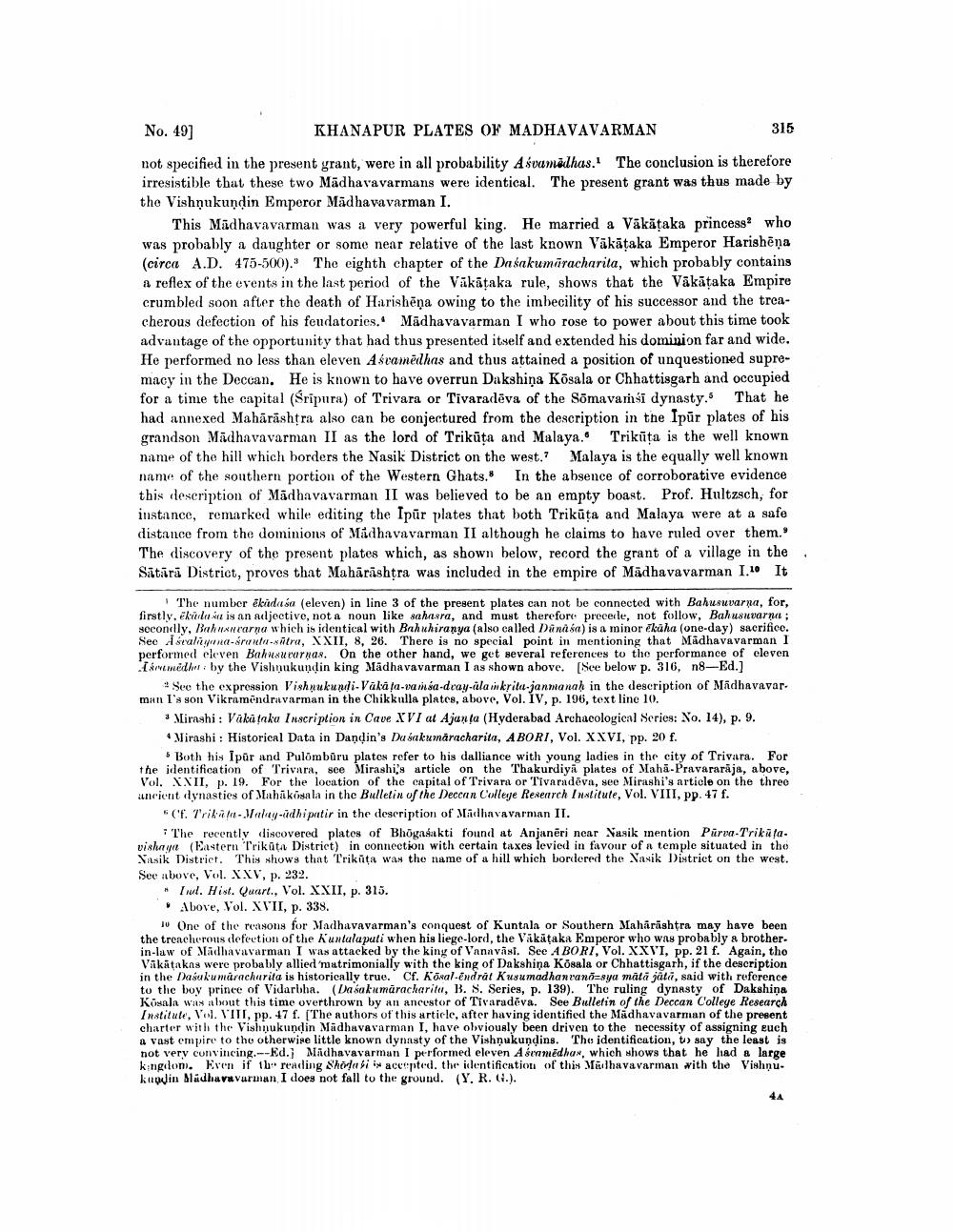________________
No. 49] KHANAPUR PLATES OF MADHAVAVARMAN
315 not specified in the present grant, were in all probability Asvumädhas. The conclusion is therefore irresistible that these two Madhavavarmans were identical. The present grant was thus made by the Vishņukundin Emperor Mādhavavarman I.
This Mādhavavarman was a very powerful king. He married a Vākāțaka princess who was probably a daughter or some near relative of the last known Vākāțaka Emperor Harishēņa (circa A.D. 475-500). The cighth chapter of the Dasakumiracharita, which probably contains a reflex of the events in the last period of the Vākāțaka rule, shows that the Vākāțaka Empire crumbled soon after the death of Harishēņa owing to the imbecility of his successor and the treacherous defection of his feudatories. Madhavavarman I who rose to power about this time took advantage of the opportunity that had thus presented itself and extended his dominion far and wide. He performed no less than eleven Asvamēdhas and thus attained a position of unquestioned supremacy in the Deccan. He is known to have overrun Dakshina Kösala or Chhattisgarh and occupied for a time the capital (Sripura) of Trivara or Tivaradēva of the Sömavarsi dynasty. That he had annexed Maharashtra also can be conjectured from the description in the Ipūr plates of his grandson Madhavavarman II as the lord of Trikūta and Malaya.. Trikūta is the well known name of the hill which borders the Nasik District on the west.? Malaya is the equally well known name of the southern portion of the Western Ghats. In the absence of corroborative evidence this description of Madhavavarman II was believed to be an empty boast. Prof. Hultzsch, for instance, remarked while editing the Ipār plates that both Trikūţa and Malaya were at a safe distance from the dominions of Madhavavarman II although he claims to have ruled over them." The discovery of the present plates which, as shown below, record the grant of a village in the Sātārā District, proves that Mahārāshtra was included in the empire of Madhavavarman I.. It
The number ēkida sa (eleven) in line 3 of the present plates can not be connected with Bahusuvarna, for, firstly. ēkudaku is an adjective, not a noun like sahasra, and must therefore preeerle, not follow, Bahusuvarna : secondly, Bahuxncarna which is identical with Bahuhiranya (also called Danasa) is a minor ēkāha (one-day) sacrifice. See Asaliya -áru-sitra, XXII, 8. 26. There is no special point in mentioning that Madhavavarman I performed cleven Bahusu carwas. On the other hand, we get several references to the performance of eleven I remedhat: by the Vishmukundin king Madhavavarman I as shown above. [See below p. 316, n8-Ed.]
* See the expression Vishnukundi-Vākā tava maa-dray-ala in krita-janmanah in the description of Madhavavar. man l's son Vikramendravarman in the Chikkulla plates, above, Vol. IV, p. 196, text line 10.
* Mirashi: Vakataka Inscription in Cave XVI at Ajanta (Hyderabad Archaeological Series: No. 14), p. 9.
Mirashi : Historical Data in Dandin's Dušakumaracharita, ABORI, Vol. XXVI, pp. 20 f.
• Both his Ipar and Pulömburu platos refer to his dalliance with young ladies in the city of Trivara. For the identification of Trivara, see Mirashi's article on the Thakurdiyā plates of Mahā-Pravararaja, above, Vol. XXII, p. 19. For the location of the capital of Trivara or Tivaradeva, see Mirashi's article on the three incientlynasties of Mahakisala in the Bulletin of the Deccan College Research Institute, Vol. VIII, pp. 47 f.
(f. Triki-Malay-udhi patir in the description of Madhavavarman II.
: The recently discovered plates of Bhogasakti found at Anjanēri near Nasik inention Purva-Trikūļa. vishay (Eastern Trikāta District) in connection with certain taxes levied in favour of a temple situated in the Yasik District. This whows that Trikato was the name of a hill which bordered the Nasik District on the west. See above, Vol. XXV, p. 232.
# Iul. Hist. Quart., Vol. XXII, p. 315.
Above, Vol. XVII, p. 338. 10 One of the reasons for Madhavavarman's conquest of Kuntala or Southern Mahārāshtra may have been the treacherous defection of the Kuntalaputi when his liege-lord, the Vākāțaka Emperor who was probably a brother. in-law of Madhavavarman I was attacked by the king of Vanavāsi. See A BORI, Vol. XXVI, pp. 21 f. Again, tho Vikatakas were probably allied matrimonially with the king of Dakshina Kosala or Chhattisgarh, if the description in the Dasukumüracharita is historically true. Cf. Kõsal-Endral Kusumadhanvanõ=sya mātā jāta, said with reference to the boy prince of Vidarbiba. (Dasa kumāracharitu, B. S. Series, p. 139). The ruling dynasty of Dakshina Kösala was about this time overthrown by an ancestor of Tivaradeva. See Bulletin of the Deccan College Research Institute, Vol. VIII, pp. 47 f. [The authors of this article, after having identified the Madhavavarman of the present charter with the Vishnukundin Madhavavarman I, have obviously been driven to the necessity of assigning euch a vast empire to the otherwise little known dynasty of the Vishņukundins. The identification, to say the least is not very convincing.--Ed. Madhavavarman I performed eleven Aśramēdhux, which shows that he had a large kingdom. Even if the reading Shorlasi is accepted, the identification of this Malhavavarman with the Vishnu. kodin Aladhava varman I does not fall to the ground. (Y. R. G.).
4A




